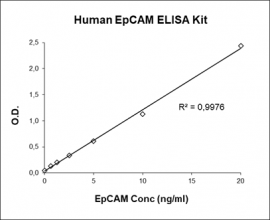Human EpCam ELISA kit
Product Specifications
- Catalogue N°
- 873.130.048 - 1 x 48 Discovery (pre-coated)
873.130.096 - 1 x 96 (pre-coated)
873.130.192 - 2 x 96 (pre-coated) - Assay Range
- 20 – 0,625 ng/ml
- Sensitivity
- 0.27 ng/ml
- Target species
- Human
- Specificity
- Recognizes both natural and recombinant EpCAM
- Incubation
- 3h45
- Sample Type
- Cell culture supernatant, serum and plasma
- Sample Size
- 50 µl
- Cross Reaction
- No cross reactivity with other cytokines tested
- Kit Content
- Diaclone ELISA Kits include pre-coated strip plates, biotinylated secondary antibody, standards, controls (where applicable), buffers, streptavidin-HRP, TMB, stop reagents and a detailed procedure.
- Synonym
- CD326
- TROP1

BACKGROUND
EpCAM (CD326) is a conserved type I transmembrane glycoprotein of 35 kDa expressed on epithelial cells. Initially discovered as a carcinoma cell surface antigen, EpCAM is also expressed in a variety of human epithelia cancers and can be then used as diagnostic or potential prognostic marker and as a potential target for immunotherapeutic strategies. EpCAM overexpression is often linked to poor prognosis, presumably due to its involvement in cancer cell proliferation, migration, and metastasis.
The name EpCAM - or Epithelial Cell Adhesion Molecule - was introduced by Litvinov and al, who showed that EpCAM can mediate Ca2 +-independent homophilic cell - cell adhesion in cells that normally lack cell - cell interactions. Human EpCAM is a polypeptide of 314 amino acids (aa), consisting of a large extracellular domain (N-terminal) of 242 aa, a single-spanning transmembrane domain of 23 aa and a short cytoplasmic domain of 26 aa (C-terminal). The gene encoding for human EpCAM is located on chromosome 2 (location 2p21). The EpCAM protein seems to be highly conserved among vertebrates, showing up to 81% amino acid sequence homology between human and mouse, and up to 99% between human and gorillas.
In healthy adult tissue, EpCAM is expressed at the basolateral cell membrane of epithelia. No expression can be detected in the differentiated cells of normal squamous stratified epithelia. In adults, EpCAM is expressed in most organs and glands, with the highest expression in colon. Generally, the level of expression differs between tissues. EpCAM is typically present in proliferating cells, and less in differentiated cells.
Soluble EpCAM, which likely is a product of intramembrane proteolysis, was first described in sera of cancer patients in 2002. In these studies, serum levels of shed EpCAM in patients were found to be in the low ng/ml range. Biochemical characterization of EpCAM has shown that its extracellular domain tends to aggregate and form multimers, most prominently tetramers.
Version 1 - 11.22
For research use only
For any order, the purchaser acknowledges having read and accepted the terms and conditions described on the Diaclone website.



